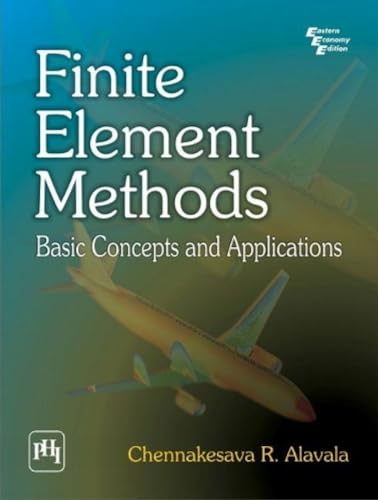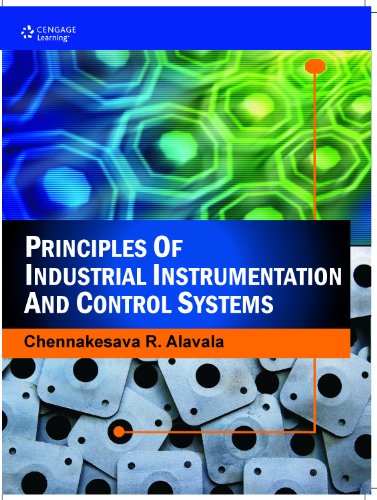Cad/cam By Chennakesava R Alavala Pdf
Posted By admin On 13.01.20
The finite element method (FEM) is a numerical technique for finding approximate solutions to partial differential equations. This book provides a detailed description of equations of equilibrium, stress-strain relations, interpolation functions and element design, symmetry and applications of FEM. This text is a synthesis of both the physical and the mathematical characteristics of finite element methods.
Besides, the book includes step-by-step procedure to solve typical problems using ANSYS® software. The text is primarily intended for the undergraduate and postgraduate students of Mechanical/Production/Civil and Aeronautical Engineering.
This textbook presents the basic principles for the use and design of computer graphics systems, as well as illustrates algorithm implementations and graphics applications.The book begins with an introduction to the subject and goes on to discuss various graphic techniques with the help of several examples and neatly drawn figures. It elaborates on methods for modelling and performing geometric transformations and methods for obtaining views in both two and three dimensions.
This up-to-date and accessible text deals with the basics of Computer Integrated Manufacturing (CIM) and the many advances made in the field. It begins with a discussion on automation systems, and gives the historical background of many of the automation technologies.
Then it moves on to describe the various techniq ues of automation such as group technology and flexible manufacturing systems. The text describes several production techniques, for example, just-in- time (JIT ), lean manufac turi ng and agil e manu fact urin g, besi des exp lain ing in deta il data base syst ems, mach ine functions, and design considerations of Numerical Control (NC) and Computer Numerical Control (CNC) machines, and how the CIM system can be modelled. The book concludes with a discussion on the industrial application of artificial intelligence with the help of case studies, in addition to giving network application and signaling approaches. Intended primarily as a text for the undergraduate and graduate students of mechanical, production, and industrial engineering and management, the text should also prove useful for the profession als in the field. Ackn owle dgem ents. Intr odu ctio n. Grou p Tech nolo gy.
Flex ible Manu fact urin g Syst ems. Shop Floo r Cont rol. Production Planning and Control. Computer Aided Process Planning. JIT-Lean Production. Open System/CIM Data Model. NC and CNC Machines.
Design Consideration of CNC Machines. Automated Guided Vehicle (AGV). Cbe style manual 6th edition. Enterprise Reso urce Plan ning (ERP). Prod uct Data Mana geme nt.
Artif icia l Inte llig ence and Simu lati on. Prog ramma ble Logi c Controller. Concurre nt Engineering.
Local Area Network Communicatio ns. Modern inertial sensors and systems cover more than five decades of continuous research and development involving various branches of science and engineering.
Cad/cam By Chennakesava R Alavala Pdf Converter
Various technologies have emerged in an evolutionary manner surpassing the earlier ones in performance and reliability. The subject is still growing with proliferation in newer cost effective applications, while its wider usage in aerospace systems continues. This book exposes the readers to the subject of inertial navigation, the inertial sensors and inertial systems in a unified manner while emphasizing the growth areas in emer ging tech nolo gies such as micr oele ctro mech anic al iner tial sens ors, satel lite nav igat ion, satel lite navi gati on integrated inertial navigation, hemispherical resonator gyro, vibrating beam accelerometer, interferometric fibre optic gyro, ine rtial sensor signal process ing, redu nda nt iner tial systems and the qui te rece nt emer genc e of cold atom interferomet er based inertial sensors. The contents are imaginatively designed that will of interest to a wide spectrum of readers. The book has been written with utmost lucidity and clarity and explanations provided with a large number of ill us tra tiv e fig ur es.
Bes id es be ing an id eal in tro du cti on to the pr in cip les of ine rti al sen sor s and sys tem s for undergraduate and postgraduate students of aerospace engineering, the topics dealt with will also be of benefit to practicing engineers and can assist the researchers to locate excellent references for research work. The authors have had three decades of design and application research experience in premier research instituti ons and have made use of their experience in giving a user-friend ly shape to the book. This text emphasizes the underlying metallurgical principles of casting technology so that the students can develop a sound set of analytic skills, helpful in the development of improved casting processes and products.
The pictorial and diagrammatic support provided throughout reinforces the clarity of the text for a thorough understanding of the metal casting concepts and technologies. Besides comprehensive coverage of the casting processes and elaborate discussion of properties of cast irons, cast steels, and cast nonferrous alloys, the text also familiarizes the students with the most recent developments in binder systems, casting practices, solidification processing, metal filtration, metallurgy of cast alloys, alloy design, and energy and environment management. The book is primarily designed for degree and diploma students pursuing courses in metallurgical, mechanical, and production engineerin g disciplines as well as for candidates studying for Associate Membership Examinations (AMIIME, AMIE, Grad.
It would also benefit M.Tech./M.E. Students specializing in foundry technology and allied disciplines.
Pri mar ily int end ed as a tex tbo ok for th e un de rgr ad uat e stu den ts of aer ona uti ca l, au tom ob ile, ci vil, in du str ial, mechanical, mechatronics and production, it provides a comprehensive coverage of all the technical aspects related to CAD/CAM. Organized in 26 chapters, the textbook covers interactive computer graphics, CAD, finite element analysis, numerical control, computer numerical control, manual part programming, computer-aided part programming, direct nume ric al cont rol, adap tive con trol syst ems, gro up tech nolo gy, comp uter -aide d proc ess plan nin g, comp uter- aide d plan ning of reso urce s for manu fact urin g, comp uter -aid ed qual ity cont rol, ind ustr ial robo ts, flex ible man ufac turi ng systems, cellular manufacturing, lean manufactu ring and computer integrated manufactu ring. Each chapter begins with objectives and ends with descriptive and multiple-choice questions. Besides students, this book would be of immense value to practicing engineers and professionals who are interested in the CAD/CAM technology.
Ackn owle dge ment s. Fun dame ntal s of CAD /CAM.
CAD /CAM Hard ware. CAD / CAM Soft ware. Interactive Computer Graphics. Basics of Geometric Modelling. Wireframe Modelling.
Surface Modelling. Solid Modelling. Comp uter -aid ed Draf ting. Fin ite Eleme nt Mode llin g. Nume ric al Cont rol. Comp uter Nume rica l Cont rol. Manu al Part Programming.
Turning Centre Programmin g. Computer-aided Part Programming. Direct Numerical Control. Adaptive Cont rol Mach inin g Sys tems. Grou p Tech nolo gy. Comp uter -aide d Proc ess Plan nin g. Comp uter -aide d Manu fact urin g Reso urce Plan ning.
Comp uter -aide d Qual ity Cont rol. Ind ustr ial Robo ts. Fle xibl e Manu fact urin g Syst ems. Cell ular Manufacturing. Lean Manufacturing. Computer-integrated Manufacturing. The impa ct of the tech nolo gy of Comp uter -Aid ed Desi gn and Manu fact urin g in auto mobi le engi neer ing, mari ne engineering and aerospace engineering has been tremendous.
Using computers in manufacturing is receiving particular prominence as industries seek to improve product quality, increase productiv ity and to reduce inventory costs. Therefore, the emphasis has been attributed to the subject of CAD and its integration with CAM. Designed as a textbook for the undergraduate students of mechanical engi neer ing, pro duc tion eng inee ring and ind ustr ial eng inee ring, it pro vide s a desc ript ion of both the hard ware and software of CAD/CAM systems.

Part I: CAD—Fundamentals of Design, Computers andControllers—Fundamentals of CAD. Computer Systems. Part II: CAD—Hard ware and Software Components— Use of Computers in CAD/CAM System.

CAD System Hardware. CAD System Software. Principles of Interactive Computer Graphics.
Transformation Systems. Wire Frame Modelling. Surface Modelling. Solid Modelling.
Part III: CAD—Design Aspects of Industrial Components—Finite Element Modelling and Analysis. Part IV: CAM—Numerical Control Production Systems. Numerical Control in Production Systems.
Computer Control of NC Machines. NC Part Programmin g and Computer Aided Part Programming. Part V: Information Systems in Manufacturing—Group Technology. Computer Aided Process Planning.
Part VI: Quality Control and Automated Inspection— Computer-Aided Inspection and Quality Control. Machine Vision. Part VII: Integratio n of Manufactu ring Systems—Compute r Integrated Production Planning Systems. Industrial Robots and Automated Guided Vehicle Systems. Flexible Manufacturing Systems. Computer Integrated Manufacturing. Part VIII: Intellig ent CAD and Manufacturi ng Systems— Artificial Intelligence and Expert System.
Communication Systems in Manufacturing. Question Bank (Computer Aided Design). Question Bank (Computer Aided Manufacturing). Objective Type Questions.
The book is a practical approach to provide the students an understanding on Computer Numerical Control (CNC) machines. The book lays a concrete foundation for the student which he can then work efficiently in the industry. Driving devices, the basic source of linear and rotary motions in machine tools, are also explained in this illustrative text along with their working principles.
Besides this there is an in-depth coverage of Part Programming, and the applications of Part Programming in CNC Lathe Programming and CNC Mill Programming. This book exposes the students to the state- of-theart technology with an engrossing discussion on the role of Robots, FMS and Computer Integrated Manufacturing (CIM) in the automated industry. The text provides some very useful PracticeQuestions, the solutions for which are provided in the Appendix. This comprehensive introduction to basic manufacturing processes is ideal for both degree and diploma courses in engineering. With several pedagogical features, the text makes the topics understan dable and appealing for students.
The book first introduces the concepts of engineering materials and their properties, measurement and quality in manufacturing and allied activities before dwelling upon the details of different manufacturing processes such as machining, casting, metal forming, powder metallurgy and joining. To keep pace with the latest advancements in technology, use of nonconventional resources, applications of computers, and use of robots in manufacturing are also discussed in considerable detail. The text also provides a thorough treatment of topics on economy and management of production. Manufacturing Concepts. Engineering Materials.
Measurements and Quality in Manufacturing. Theory of Metal Cutting. Turning Operations. Drilling and Allied Operations. Shaping, Planing and Slotting Operations. Milling Operations.
Finishing Processes. Phase Change Processes for Material Property Manipulation. Casting Processes. Metal Forming Processes.
Sheet-metal Working. Powder Metallurgy. Mechanical Joining Processes. Processing of Plastics.
Non-conventional Resources in Manufacturing. Computer Controlled Manufacturing Systems. Economics of Manufacturing.
Cad/cam By Chennakesava R Alavala Pdf Software
Production Management. Power Transmission in Machine Tools. Objective Type Questions.